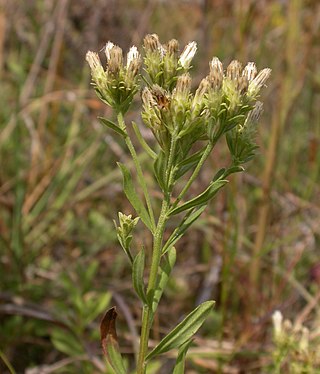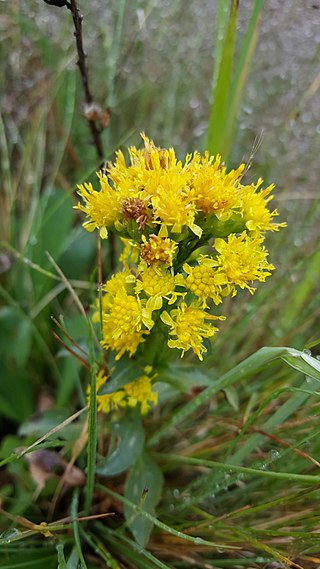
Ionactis, common name stiff-leaved asters or ankle-asters, is a small genus of plants belonging to the family Asteraceae. These aster-like plants are endemic to North America. One species is widespread across much of the eastern half of the continent, while two others are rare endemics with very restricted ranges.

Tripolium pannonicum, called sea aster or seashore aster and often known by the synonyms Aster tripolium or Aster pannonicus, is a flowering plant, native to Eurasia and northern Africa, that is confined in its distribution to salt marshes, estuaries and occasionally to inland salt works.

Astereae is a tribe of plants in the family Asteraceae that includes annuals, biennials, perennials, subshrubs, shrubs, and trees. They are found primarily in temperate regions of the world. Plants within the tribe are present nearly worldwide divided into over 250 genera and more than 3,100 species, making it the second-largest tribe in the family behind Senecioneae.

Chrysopsis are plants in the family Asteraceae native to the southern and eastern United States. All the species are found in Florida, although some are found in other states as well.

Erigeron aphanactis is a species of flowering plant in the family Asteraceae known by the common name rayless daisy, or rayless shaggy fleabane. This wildflower is native to the western United States, primarily the Great Basin and Colorado Plateau regions.

Erigeron inornatus is a North American species of flowering plant in the family Asteraceae known by the common name California rayless daisy, California rayless fleabane, rayless fleabane, Lava rayless fleabane

Eucephalus breweri is a North American species in the family Asteraceae known by the common name Brewer's aster. It is native to California where it grows primarily in the Sierra Nevada at subalpine elevations. Its range extends into northwestern Nevada and southwestern Oregon.

Eucephalus engelmannii is a North American species in the family Asteraceae known by the common name Engelmann's aster. It is native to the United States and Canada from Alberta and British Columbia to far northern California and Colorado.

Brickellia greenei is a species of flowering plant in the family Asteraceae known by the common name Greene's brickellbush. It is native to the mountain ranges of southwestern Oregon and northern California, including the Cascades, the northern Coast Ranges, and Sierra Nevada.

Sericocarpus is a genus of North American plants in the tribe Astereae within the family Asteraceae. Whitetop aster is a common name for the genus.

Eucephalus is a genus of North American flowering plants in the family Asteraceae.

Senecio aphanactis, known by the common names chaparral ragwort, rayless ragwort, and California groundsel, is a species of flowering plant in the aster family.

Senecio aronicoides is a species of flowering plant in the aster family known by the common name rayless ragwort. It is native to Oregon and northern and central California, where it can be found in the woodlands and forests of mountains and foothills, often in relatively dry habitat. It is a biennial or perennial herb growing up to about 90 centimeters tall from a fleshy root attached to a buttonlike caudex. The plant is often slightly woolly or cobwebby in texture. The leaves have lance-shaped to oval blades measuring up to 20 centimeters long, the largest ones lower on the stem. The inflorescence is a corymb which is flat and spreading, often resembling an umbel. The flower heads are cups lined with black- or green-tipped phyllaries and filled with many gold disc florets. There are usually no ray florets but one or two occasionally emerge from a head. The fruit is a hairless achene tipped with a pappus of long, white bristles.

Eucephalus vialis is a rare North American species of flowering plant in the family Asteraceae known by the common name wayside aster. It is native to southwestern Oregon and northwestern California in the United States.

Eucephalus ledophyllus is a North American species of flowering plant in the family Asteraceae known by the common name Cascade aster. It is native to Washington, Oregon and northern California in the United States, mostly in the Cascade Mountains. Some of the populations are inside national parks and monuments: Mount Rainier National Park, North Cascades National Park, and Mount St. Helens National Volcanic Monument.

Eucephalus elegans is a North American species of flowering plants in the family Asteraceae known by the common name elegant aster. It is native to the western United States, largely the Great Basin, in the states of Colorado, Idaho, Montana, Nevada, Oregon, Utah, Wyoming.

Eucephalus paucicapitatus is a North American species of flowering plant in the family Asteraceae known by the common name Olympic Mountain aster. It grows on rocky slopes and in subalpine meadows at high elevations in and near Olympic National Park in the US State of Washington, and on Vancouver Island in the Canadian Province of British Columbia.
Eucephalus glaucescens is a North American species of flowering plant in the family Asteraceae known by the common name Klickitat aster. It grows on rocky slopes and in subalpine meadows at high elevations on and near Mount Adams in the south-central part of the US State of Washington.
Eucephalus gormanii is a North American species of flowering plant in the family Asteraceae known by the common name Gorman’s aster. It grows on rocky slopes and on cliffs at high elevations in the Cascade Mountains of the US State of Oregon.
Eucephalus glabratus is a North American species of flowering plant in the family Asteraceae with the common names of smooth aster, smooth wayside-aster, and Siskiyou aster. It is a perennial herb up to 60 centimeters tall, with branching rhizomes. Stems and leaves are hairless or nearly so. One plant will usually produce 3–8 flower heads per stem. Each head has 0–4 violet ray florets surrounding numerous yellow disc florets.

















